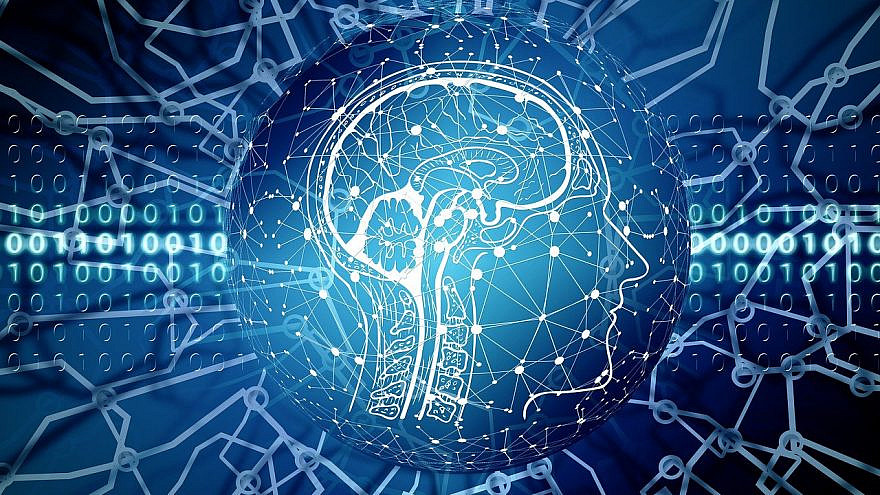
An artist’s rendition of artificial intelligence. Credit: Pixabay.
Prof. Sam Lehman-Wilzig – Judaism and Artificial Intelligence: Shavuot Shows the Connection
What does Judaism have to “say” about Artificial Intelligence (AI)? The question demands attention with AI algorithms running rampant these days: ChatGPT, OpenAI, etc. Interestingly, the holiday of Shavuot is as good a time as any to provide an answer.
We are living these days in a world of increasing virtuality, roughly defined as something (actually, some NOT-thing): 1- lacks physicality (e.g., a dream, computer memory); 2- offers only a partial (re)presentation of the “real” (e.g., a two-dimensional picture, light reaching us after millions of years from distant galaxies that no longer exist); or 3- incorporates potentiality to become something else (an acorn is an oak tree in virtual form).
It goes without saying that only humans deal in virtuality – animals do not create “external” virtuality, because they cannot think “abstractly” (e.g., rationally planning the future) – and they are also not aware of their own “internal virtuality.” People, on the other hand, are involved everywhere in virtuality: literature (fictional characters), economics (paper money has no intrinsic value; electronic banking doesn’t involve any physical transfer of money); nations are (un)really imagined communities (of the nine million, how many Israelis do you really know or have ever connected to?); physics (we can’t seem to find dark energy and dark matter, making up 96% of the universe!); light as a photon and wave); media (most communication these days is with people we are not in close proximity to); etc.
So why should anyone be surprised that religion too is a mostly virtual phenomenon. After all, when was the last time you actually heard God speaking to you? For that matter, have you ever seen God; touched the Almighty? Had you asked that question of pagans a few thousand years ago, the answer would have been “yes”: idols! It was Judaism that gradually weaned us away from materialistic conceptions of God, to a far more advanced virtual conception. To be clear: “virtual” does not mean “nonexistent” but only “unseen,” non-material; perhaps to an extent also “unknowable.”
When do we first see this in the Torah? During the giving of the Ten Commandments on Mount Sinai, the post-agricultural raison d’etre of the Shavuot holiday. Here are the relevant verses in Exodus 33, verses 18, 20, 22, 23 (these are not read on the holiday, but are part of the Mount Sinai narrative, found a bit later in the Book of Exodus): And Moses said [to God]: ‘Show me, I pray Thee, your glory.’… God said: ‘You cannot see My face, for Man shall not see Me and live.’… …while My glory passes by, I will put you in a rock cleft, and will cover you with My hand until I have passed by…. And I will take away My hand, and you shall see My back; but My face shall not be seen.’
The Almighty is unseeable and unknowable. First, invisible. Second, inscrutable. Perhaps the only thing we can “know” is what God did in the past (God’s “back”) but not what will be done in the future (God’s “face”).
Another virtual aspect is what God told Moses earlier when the latter asked what he should tell the Israelites about “God” (Exodus 3: 14): “And God said unto Moses: I will be what I will be.” Not: “I am what I am.” In other words, God can also change. Here is virtuality as “potentiality.” To a large extent, Judaism’s God “becomes” what we make of Him; not in the sense of “inventing” God, but rather by our acting morally or immorally God will “be”, based on what we do.
That emerges time and again throughout the Torah, when the Almighty promises blessings and threatens curses, depending on our behavior. Thus, it is not only God that is “virtual,” but also our own future holds great virtual potentiality depending on how we act.
After the destruction of the Second Temple, Judaism added two more virtual layers – instead of material Temple sacrifice, now spiritual prayer and intellectual learning/scholarship became the core of its religious tradition. Jews have been doing that now for 2000 years – great practice for our virtual age (a major reason for Jewish professional success in the modern era). Which brings us to the latest virtuality iteration: artificial intelligence. Is it a mere coincidence that the first major AI researcher in the 1960s – MIT’s Joseph Weizenbaum – was Jewish? I doubt it.
This is not to say that Judaism accepts AI wholeheartedly. The world’s first (apocryphal) AI was the Golem of Prague, and because of its potential harm it had to be “decommissioned.” Weizenbaum, too, soured on his AI program Eliza. Yet conversely, the Israelites went astray creating the very physical (non-virtual) Golden Calf at the base of Mount Sinai.
In the final analysis, then, Judaism in large part is based on virtuality but seeks the correct balance with the material world. That’s just like the two physical tablets of the Ten Commandments – upon which we are instructed and charged with recalling that a very virtual Almighty was the One who led the Israelites physically out of Egypt.







